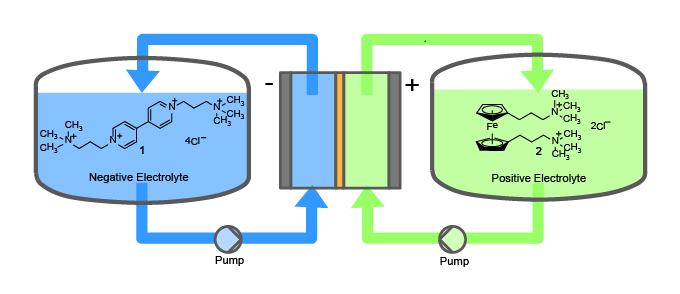Product Document Searching Made Easy by 2D Code! | TCI Chemistry News October 2025 | [TCIPracticalExample] Di-Cbz Guanidinylation of Amine... | Various analytical charts can be searched on each product detail page and Product Document Search (The kinds of analytical charts differ by product)
Maximum quantity allowed is 999
请选择数量
Aqueous Organic Redox Flow Battery Materials Providing High Cycling Stability
No.179(November 2018)
Redox flow batteries (RFB), which have advantages in terms of size and capacity scalability, have been investigated mainly using inorganic materials, whereas organic materials have been comparatively overlooked. In recent years, organic redox flow batteries (ORFB) using organic materials have been receiving much attention, particularly because they are composed of earth-abundant elements. Recently, Gordon and Aziz et al. have developed viologen (1) and ferrocene (2) derivatives bearing trimethylammoniopropyl groups as aqueous ORFB materials.1) The reduction potential of 1 and oxidation potential of 2 are -0.358 V and +0.390 V (vs. SHE) respectively, and feature several advantages: high solubility in water (up to 2.0 M), applicability to neutral pH systems, and high chemical and electrochemical stability. An ORFB comprised of these materials (Fig. 1) has marked very high cycling stability up to 99.9989%/cycle at 0.75-1.00 M.

Figure 1. An illustration of a RFB using 1 and 2
References
- 1)A neutral pH aqueous organic−organometallic redox flow battery with extremely high capacity retention
The prices are subject to change without notice. Please confirm the newest price by our online catalog before placing an order.
In addition, sales products changes with areas. Please understand that a product is not available when the product details page is not displayed.
In addition, sales products changes with areas. Please understand that a product is not available when the product details page is not displayed.